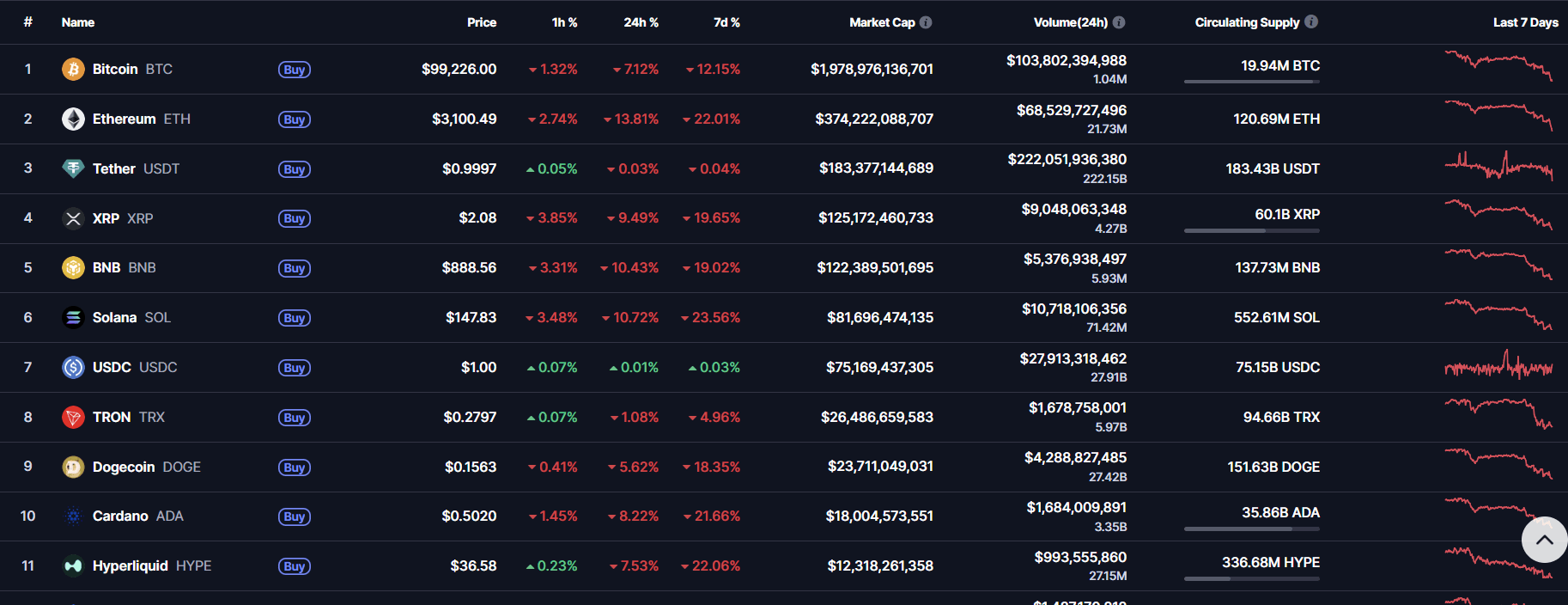Ethereum Crash Deepens: Can the $3K Line Hold or Will It Break Next?
The crypto market is in freefall , and Ethereum is one of the hardest hit.
Following Bitcoin’s sharp decline under $100K, $ETH plunged over 13% in a single day, wiping out weeks of gains and reigniting fears of a deeper bear trend.
Ethereum Price Crash Toward $3,000
$Ethereum crashed from around $3,600 to nearly $3,100, breaking several key support zones. The 200-day SMA at $3,370 has been breached, confirming a bearish trend continuation.
ETH/USD 1-day chart - TradingView
RSI has dropped to 43, indicating rising selling pressure but not yet fully oversold.
MACD remains in negative territory, with widening divergence — a clear sign that momentum is still heavily bearish.
Bitcoin Crash Triggered the Avalanche
Bitcoin’s breakdown below $100K acted like a domino effect across all markets.
Ethereum, BNB, Solana, Cardano, and Dogecoin all saw steep declines as liquidations exceeded $100 billion in 24h trading volume across top exchanges.

Solana dropped 23%, Cardano lost 21%, and BNB tumbled nearly 10%.
The entire crypto market capitalization has now fallen below $3.6 trillion.
Ethereum Price Prediction: Key Levels to Watch for ETH
If Ethereum fails to hold above the $3,000 mark, the next strong supports lie at $2,730 and $2,400.
A rebound may occur if BTC finds stability near $100K, potentially sending ETH back toward $3,500.
However, sentiment remains extremely bearish — and any short-term rally could face resistance near the $3,370–$3,800 range.
Will Ethereum Price Recover?
Both $Bitcoin and $Ethereum have entered dangerous territory.
While the RSI readings suggest short-term exhaustion among sellers, macro factors — including liquidations, investor fear, and risk-off sentiment — continue to weigh on the market.
Until $BTC reclaims $106K or $ETH climbs above $3,500, the crypto correction is far from over.
Disclaimer: The content of this article solely reflects the author's opinion and does not represent the platform in any capacity. This article is not intended to serve as a reference for making investment decisions.
You may also like
Modern Monetary Theory and Market Outlook for 2026: Does Bold Investment in Stocks and Emerging Economies Make Sense?
- Modern Monetary Theory (MMT) sparks debate in 2025 as governments expand fiscal spending amid inflation and AI-driven economic shifts. - Proponents argue deficit spending boosts growth, while critics warn of inflation risks and fiscal unsustainability as U.S. deficits hit $7 trillion. - Fed officials clash over policy: Hammack prioritizes inflation control, while Jefferson advocates patience as AI reshapes labor markets. - MMT-driven liquidity could lift emerging markets if Fed rates stay low, but sudden

The Emergence of Hyperliquid and What It Means for Retail Crypto Traders
- Hyperliquid dominates 73% of Q1 2025 crypto trading with its HyperBFT blockchain, 0.2-second block times, and transparent HLP liquidity pools. - The platform maintained 100% uptime during 2025's market crash, processing $10B in liquidations while Binance faced outages and refunds. - 21Shares filed an ETF for Hyperliquid's HYPE token (now 11th largest crypto at $12.6B), while $645M in buybacks boosted institutional confidence. - Hyperliquid captured 15% of Binance's volume via permissionless market creati

Bitcoin’s Price Fluctuations and Systemic Risks: Managing Institutional Withdrawals and Changes in the Macroeconomic Landscape
- Bitcoin's Q3 2025 ETF outflows reached $1.15B, driven by Fidelity and Ark, reflecting institutional risk recalibration amid structural vulnerabilities. - Macroeconomic factors like Fed rate cuts and U.S.-China tensions amplified Bitcoin's volatility, triggering an 18% price correction in October 2025. - ETFs now hold 6.7% of all Bitcoin , creating liquidity concentration risks as redemptions and inflows directly reshape exchange order-book dynamics. - Regulatory shifts, including India's SEBI trading cur

LUNA declines by 2.85% in the past 24 hours, marking a 78.61% decrease over the last year
- LUNA plummeted 2.85% in 24 hours to $0.0888, despite a 8.7% weekly rise, amid a 78.61% annual decline. - Analysts highlight structural concerns as RSI and moving averages signal bearish trends, contrasting short-term optimism. - A 2022 backtest showed LUNA outperformed markets during 5% surges, underscoring resilience amid crypto volatility.
